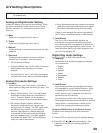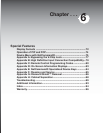
72
Display Formats
Caution should be observed when using
the Narrow format due to the stationary
gray side bars. Please see guidelines
concerning stationary images, page 54.
IMPORTANT
Press FORMAT on the TV remote control to cycle
through the available display formats. The last used
format for each device will be used when you return to
that device.
Note: Not all formats are available for
PIP/POP. Side-by-Side, 3 POP and 9 POP are
only available in Standard and Expand formats.
Format Signals:
480i Signals: Traditional analog interlaced signals from or
through Ant-1 & 2, Inputs 1, 2 & 3, and Component 1 & 2.
480p Signals: Progressive scan analog DVD signals through
signals on Component-1 & 2.
1080i Signals: High definition analog signals received
through signals on Component-1 & 2.
SD 4:3: Standard definition narrow screen format signals
from digital channels and IEEE 1394 devices.
SD 16:9: Standard definition wide screen format signals
from digital channels and IEEE 1394 devices.
HD: High definition wide screen format signals from
digital channels and IEEE-1394 devices.
Format Definitions:
Standard: Full screen format used by HDTV signals.
Also useful when displaying 1.78:1 or 1.85:1 aspect
ratio Anamorphic DVDs. Anamorphic DVDs that have a
2.35:1 aspect ratio will still display black bars at the top
and bottom, but will show the entire image correctly.
Narrow (4:3) images will be stretched evenly from side
to side. Available for all signals.
Expand: Enlarge the picture to fill the screen, cropping
off some of the image at the top and bottom. Useful
for reducing the letterbox top and bottom bars of non-
anamorphic DVD. Available for analog 480i, 480p and
digital SD 4:3 signals only.
Zoom: Enlarges the picture, cropping off some of the
image at each side and top and bottom. Useful for
removing or reducing the black top and bottom bars on
anamorphic DVDs with a 2.35:1 aspect ratio. Available
for analog 480i and 480p and SD 4:3 signals only.
Stretch: Stretches a narrow (4:3) image across the
screen, with less stretch in the center than the sides.
Allows the entire narrow image to be displayed across
DVD Definitions:
Anamorphic (or “Enhanced for Widescreen TV’s):
These DVDs are recorded in a special way to properly
show widescreen images on 16:9 TV sets in the
Standard format mode. This is the recommended
choice.
Non-Anamorphic (or 4:3, 1:33:1, Letterbox or Full
Screen):
These DVDs are recorded for use with traditional
shaped TVs. They may be full screen (4:3 or 1:33:1)
which crops movies to fit the narrow TV, or Letterboxed
which adds black top and bottom bars.
This information may or may not be listed on the DVD
case. Some DVDs support both types of recordings.
the screen with less distortion than seen in the
Standard format. Available for analog 480i and 480p
and SD 4:3 signals only.
Stretch Plus: Similar to stretch mode, however
to minimize distortions on the side, the picture is
expanded to crop off portions of the top and bottom.
Useful when no important information is shown at the
top and/or bottom of the screen. Available for analog
480i and 480p and SD 4:3 signals only.
Narrow: Displays narrow (4:3) images in their original
shape, and adds stationary black side bars to fill the
screen. Available for 480i, 480p and digital SD 4:3
signals only.
Wide Expand: Enlarges the picture, cropping some
of the image on both sides. Useful for removing or
reducing black side bars on HD broadcasts of 720p,
converted to 4:3 images with black bars. Available for
analog 1080i, digital SD 16:9 and digital HD signals.
This is a widescreen TV (also known as a 16:9 TV). This shape reflects the new types of images available from HDTV
and many DVDs. There are still many older style narrow screen images (called 4:3 aspect ratio) you will encounter.
While there will never be a perfect solution for displaying a narrow image on a wide screen, Mitsubishi offers several
display formats to choose from.


















